
I’ve spent years driving electric vehicles, and Tesla’s lineup has always caught my eye for its blend of performance, tech, and style.
In this article, I’ll compare the Tesla Model S and Model Y, sharing my experiences behind the wheel of both.
From their sleek designs to their practical differences, I’ll break down the pros, cons, and key features to help you decide which fits your life. With a detailed comparison table, maintenance tips, and an FAQ, my goal is to give you a clear, engaging, and analytical perspective on these two EVs.
Comparison Table
| Feature | Tesla Model S | Tesla Model Y |
|---|---|---|
| Price | Starts at $92,990 (Long Range) | Starts at $44,990 (Long Range RWD) |
| Range | 402-723 km (EPA est.) | 350-455 km (EPA est.) |
| Acceleration | 0-60 mph in 3.1 sec (Long Range) | 0-60 mph in 4.2 sec (Long Range AWD) |
| Top Speed | 155-200 mph | 135-155 mph |
| Seating | Up to 5 | Up to 7 (optional third row) |
| Cargo Space | 28.0 cu. ft. (rear + frunk) | 72.1 cu. ft. (rear + frunk, seats folded) |
| Vehicle Type | Full-size sedan | Crossover SUV |
| Screen Size | 17-inch tilting touchscreen | 15.4-inch touchscreen |
| Ground Clearance | 5.5 inches | 6.6 inches |
| Warranty | 4-year/50,000-mile; 8-year/150,000-mile battery | 4-year/50,000-mile; 8-year/120,000-mile battery |
My Experience With Tesla Model S
Sliding into the Tesla Model S feels like stepping into a spaceship. The first thing that hits you is the massive 17-inch touchscreen dominating the dashboard, controlling everything from navigation to the air vents.
My test drives in the Long Range model left me grinning ear to ear—its 3.1-second sprint to 60 mph is no joke. The acceleration pins you to the seat, and the air suspension smooths out rough roads, making long highway drives a breeze. I’ve taken it on a 300-mile road trip, and the 402-mile EPA-estimated range held up well, even with spirited driving.
The interior is minimalist but luxurious, with premium materials and a quiet cabin that makes you forget you’re in an EV. The yoke steering option, which I tried, was polarizing—it’s futuristic but takes time to master for tight maneuvers.
Parking lots were a bit tricky at first, but I adapted. The Model S also shines with its tech: over-the-air updates kept the software fresh, and the Autopilot system handled highway cruising with ease, though I stayed alert for interventions. However, the high price tag—starting at $92,990—made me pause, especially when repairs like a $550 tire replacement stung more than expected.
Space is decent for a sedan, with a roomy trunk and frunk, but it’s not ideal for families needing extra seats. I found the lack of door bins annoying for quick storage, and the absence of Apple CarPlay was a bummer for seamless phone integration. Still, the Model S feels like a statement—a car for those who want top-tier performance and cutting-edge tech, even if it comes at a premium.
Pros Of Tesla Model S

- Unmatched Performance: The Model S Long Range hits 0-60 mph in 3.1 seconds, and the Plaid version is even faster at 2.1 seconds, outpacing most gas-powered sports cars.
- Impressive Range: With an EPA-estimated 402-723 km, it’s a road-trip king, letting me drive from city to city without range anxiety.
- Luxurious Interior: The premium materials, ventilated seats, and HEPA air filtration create a comfortable, high-end cabin experience.
- Advanced Tech: The 17-inch tilting touchscreen is a tech lover’s dream, controlling nearly all functions, with regular over-the-air updates keeping it current.
- Smooth Ride: The adaptive air suspension absorbs bumps, making it ideal for long drives, and the quiet cabin enhances the luxury feel.
- Safety Features: A five-star NHTSA rating, Tesla Vision with 360-degree cameras, and automatic emergency braking provide top-tier protection.
- Charging Flexibility: Access to Tesla’s Supercharger network adds up to 200 miles of range in 15 minutes, perfect for quick stops.
Also read: My Thoughts on Acura ILX Vs. Honda Accord
Cons Of Tesla Model S
- High Cost: Starting at $92,990, it’s nearly double the Model Y’s base price, and repairs like aluminum body panels can be pricey.
- Limited Practicality: Only seats five, with no option for extra rows, and the trunk opening restricts larger items compared to a hatchback.
- Outdated Interior Design: The cabin, while luxurious, feels dated in some areas, like the lack of door bins or rear armrests.
- Yoke Steering Challenges: The optional yoke is awkward for parking or tight turns, requiring a learning period to feel natural.
- No Apple CarPlay/Android Auto: The absence of these integrations frustrates users who rely on smartphone mirroring for navigation and media.
- Maintenance Costs: Out-of-warranty repairs, like $550 for a pair of rear tires, are steep compared to smaller Tesla models.
- Depreciation: The Model S faces significant value loss over time, which can sting for buyers planning to resell.
Maintenance Tips For Tesla Model S
- Monitor Tire Wear: The Model S’s powerful acceleration wears tires quickly; check tread depth monthly and rotate every 6,000 miles to extend life.
- Keep Software Updated: Regularly accept over-the-air updates to improve performance, fix bugs, and enhance features like Autopilot or battery efficiency.
- Clean HEPA Filter: Replace or clean the HEPA filter every two years to maintain air quality and HVAC efficiency, especially in dusty areas.
- Inspect Brake Pads: Regenerative braking reduces wear, but check pads annually, as city driving can still cause gradual wear over time.
- Charge Smartly: Use a Level 2 home charger and limit Supercharging to preserve battery health; aim for 20-80% charge cycles.
- Check Suspension: The air suspension needs periodic inspection for leaks or wear, especially if you notice uneven ride height or noise.
- Wiper Blade Replacement: Replace wiper blades yearly to ensure clear visibility, as the large windshield can collect debris quickly.
My Experience With Tesla Model Y
Driving the Tesla Model Y feels like the perfect middle ground between practicality and fun. I took a Long Range AWD model for a spin, and its 4.2-second 0-60 mph time was plenty quick for daily driving.
The higher ground clearance (6.6 inches) made it a champ on bumpy roads or light off-pavement trails, unlike the lower-slung Model S. The crossover design offers a hatchback and optional third-row seating, which I tested with friends—it’s snug but works for short trips with kids.
The 15.4-inch touchscreen is intuitive, though slightly smaller than the Model S’s, and controls everything from climate to Netflix (for charging stops). I loved the panoramic glass roof, which made the cabin feel airy, and the 72.1 cubic feet of cargo space (with seats folded) easily swallowed camping gear.
Features like Dog Mode and Sentry Mode added convenience, letting me leave my pet in a climate-controlled cabin or monitor the car remotely. The Model Y’s $44,990 starting price feels like a bargain compared to the Model S, though build quality—like panel gaps—wasn’t always perfect.
On a 200-mile road trip, the 327-mile range (Edmunds-tested) was reliable, but I noticed the ride wasn’t as plush as the Model S’s air suspension. The lack of Apple CarPlay annoyed me, and the rear visibility through the small window was limited, though cameras helped. Overall, the Model Y is a versatile, family-friendly EV that balances cost and capability.
Pros Of Tesla Model Y

- Affordable Price: Starting at $44,990, it’s significantly cheaper than the Model S, making it accessible for more buyers.
- Versatile Design: The crossover SUV body offers 72.1 cubic feet of cargo space and an optional third row for up to seven passengers.
- Solid Range: Up to 455 km (EPA est.) is great for daily commutes and road trips, with minimal range anxiety.
- Nimble Handling: The higher ground clearance and compact size make it agile in urban settings and light off-road conditions.
- Practical Features: Dog Mode, Sentry Mode, and a tow hitch option add utility for pet owners and outdoor enthusiasts.
- Safety Ratings: A five-star NHTSA rating, low center of gravity, and active safety systems ensure excellent protection.
- Supercharger Access: Adds up to 151 miles in 15 minutes, making long-distance travel convenient and efficient.
Cons Of Tesla Model Y
- Build Quality Issues: Inconsistent panel gaps and fit-and-finish problems can detract from the premium feel.
- Less Luxurious Ride: The standard suspension isn’t as smooth as the Model S’s air suspension, especially on rough roads.
- Limited Rear Visibility: The small rear window hampers visibility, relying heavily on cameras for reversing.
- No Apple CarPlay/Android Auto: Like the Model S, it lacks smartphone integration, which can frustrate tech-savvy drivers.
- Snug Third Row: The optional third row is cramped, suitable only for small children on short trips.
- Range Lag: The 350-455 km range is solid but falls short of the Model S’s longer-range options.
- Noise Insulation: The cabin lets in more road noise than the Model S, reducing the luxury experience.
Read more: My Thoughts on GMC Terrain Vs. Ford Escape
Maintenance Tips For Tesla Model Y
- Tire Rotation: Rotate tires every 6,000 miles to ensure even wear, as the AWD models can stress tires unevenly.
- Software Updates: Install over-the-air updates promptly to optimize battery management and enhance features like Sentry Mode.
- Clean Glass Roof: Use a mild cleaner weekly to keep the panoramic roof clear of smudges and maintain visibility.
- Check Battery Health: Monitor charge habits via the app and avoid frequent 100% charges to prolong battery life.
- Inspect Brakes: Check brake pads every 12 months, as regenerative braking doesn’t eliminate wear in stop-and-go traffic.
- Wiper Maintenance: Replace wiper blades annually to handle rain and debris, given the large glass roof’s exposure.
- Alignment Checks: Verify wheel alignment yearly to prevent uneven tire wear, especially with the Model Y’s higher ground clearance.
Frequently Asked Questions (FAQ)
The Model S is a full-size sedan with a longer range (402-723 km) and faster acceleration (0-60 mph in 3.1 seconds), starting at $92,990. The Model Y is a crossover SUV with more cargo space (72.1 cu. ft.), optional third-row seating, and a lower price ($44,990), but a shorter range (350-455 km).
The Model S is popular for its blistering performance, long range, luxurious interior, and cutting-edge tech like the 17-inch touchscreen and Autopilot. Its status as Tesla’s flagship sedan and its role in redefining EVs attract buyers seeking premium electric driving.
The Model Y has build quality issues, a less luxurious ride, limited rear visibility, no Apple CarPlay, a cramped optional third row, a shorter range than the Model S, and more cabin noise.
Both have five-star NHTSA ratings and similar safety features, like automatic emergency braking and Tesla Vision. The Model S has a slightly longer battery warranty (150,000 miles vs. 120,000), but safety is comparable due to shared tech and robust designs.
Conclusion: For Tesla Model S And Model Y
You’re probably wondering which Tesla is right for you, and I get it—it’s a tough call. The Model S is your go-to if you crave jaw-dropping performance, a luxurious ride, and the longest range for epic road trips. But its high price and limited practicality might make you hesitate.
The Model Y, on the other hand, offers versatility, a lower cost, and family-friendly features like extra seating and cargo space, though it sacrifices some refinement. Think about your priorities: speed and luxury or affordability and utility? Either way, both cars deliver Tesla’s signature tech and eco-friendly vibe, so you can’t go wrong—just pick the one that fits your life.

